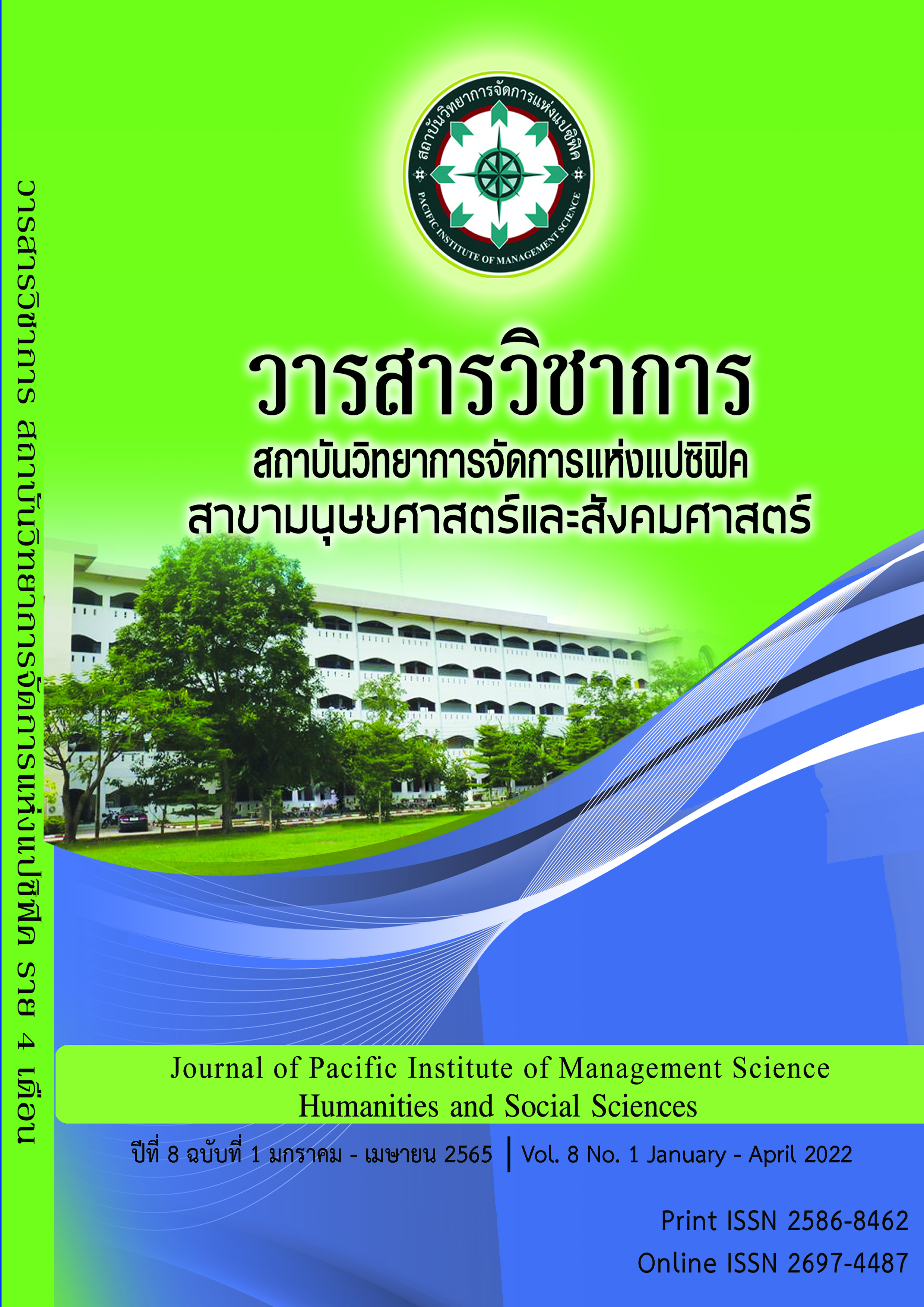The Development of Learning Management Model for Reading and Writing Spelling Entitled Spelling Scale by Using Mind Map in Thai Language Learning Subject for Prathomsuksa 2 Students
Keywords:
The Development of Model, Spelling Scale, Mind MapAbstract
The development of learning management model for reading and writing spelling entitled spelling scale by using mind map in Thai language learning subject for Prathomsuksa 2 students aimed to (1) study basic information for developing learning management style for reading and writing spelling entitled spelling scale by using mind map in Thai language learning subject for Prathomsuksa 2 students, (2) to create and develop learning management model for reading and writing spelling entitled spelling scale by using mind map in Thai language learning subject for Prathomsuksa 2 students to be effective according to the determined criterion at 80/80, (3) to try out and examine the effectiveness index of learning management model for reading and writing spelling entitled spelling scale by using mind map in Thai language learning subject for Prathomsuksa 2 students, (4) to compare the results of learning management model for reading and writing spelling entitled spelling scale by using mind map in Thai language learning subject for Prathomsuksa 2 students, and (5) to study the satisfaction of the students towards learning management model for reading and writing spelling entitled spelling scale by using mind map in Thai language learning subject for Prathomsuksa 2 that the researcher followed the conceptual framework of research and development. The samples were 38 Prathomsuksa 2/1 students of Chumchonwimonwitthaya Municipality School, Muang District, Trat Province who studied in the second semester of the academic year 2019. They were selected by Cluster Random Sampling with the drawing lots and the classroom as a random unit. The instruments used in this research were a learning management plan entitled spelling scale by using mind map, a reading and writing spelling skill practice, an achievement test in reading and writing spelling, an opinion questionnaire, and a satisfaction questionnaire. The statistics employed in data analysis were percentage, mean, standard deviation, efficacy (E1/E2), effectiveness index (E.I.), t-test (Dependent Samples), and content analysis.
The research results were as follows:
1. The 9 subjects of learning management model for reading and writing spelling entitled spelling scale by using mind map in Thai language learning subject for Prathomsuksa 2 students had the element in the aspect of learning objective and content which related to the indicators and subjects of the core curriculum (Core of Basic Education 2008). It revealed that the Thai teachers needed to develop various skill practices, the book had beautiful illustrations and attracted the students’ attention. The students should train from easy to difficult, and the content of the practice should be words that the students often read and wrote incorrectly.
2. The efficacy of learning management model for reading and writing spelling entitled spelling scale by using mind map in Thai language learning subject for Prathomsuksa 2 students revealed the efficacy value at 85.38/86.84 which was higher than the determined criterion at 80/80.
3. The effectiveness index of the students who learned through learning management model for reading and writing spelling entitled spelling scale by using mind map in Thai language learning subject for Prathomsuksa 2 students was 0.7813 that revealed the higher learning achievement at 78.13 percent.
4. The learning achievement of the students who learned through learning management model for reading and writing spelling entitled spelling scale by using mind map in Thai language learning subject for Prathomsuksa 2 students reveled higher achievement and statistically significant different at the .05 level.
5. The overall satisfaction of the students towards learning management model for reading and writing spelling entitled spelling scale by using mind map in Thai language learning subject for Prathomsuksa 2 students was at the high level.
References
กระทรวงศึกษาธิการ. (2551). หลักสูตรแกนกลางการศึกษาขั้นพื้นฐาน พุทธศักราช 2551.
กรุงเทพฯ: โรงพิมพ์คุรุสภาลาดพร้าว.
กันตพัฒน สุวรรณเรือง. (2562). การพัฒนาทักษะการเขียนสะกดคําตามมาตราตัวสะกดโดยใชชุด
ฝกทักษะกลุมสาระการเรียนรูภาษาไทยของนักเรียนชั้นประถมศึกษาปที่ 3. สาขาวิชาหลักสูตรและการสอนคณะครุศาสตร. ว.มรว. ปีที่ 13 ฉบับที่ 12 : มหาวิทยาลัยราชภัฏมหาสารคาม.
กฤตยากาญจน์ อินทร์พิทักษ. (2562). การพัฒนาความสามารถการอ่านและการเขียนคำภาษาไทย นักเรียนชั้นประถมศึกษาปีที่ 2 ด้วยกิจกรรมการเรียนรู้ตามแนวคิดสมองเป็นฐาน. การศึกษามหาบัณฑิต สาขาวิชาหลักสูตรและการสอน. มหาสารคาม: มหาวิทยาลัยมหาสารคาม.
กลิ่นขจรไพร พิลาศรี. (2556). ผลการจัดการเรียนรู้ภาษาไทยเรื่องการอ่านและการเขียนสะกดคำชั้นประถมศึกษาปีที่ 1 โดยใช้แผนผังความคิด. การศึกษามหาบัณฑิต สาขาวิชาหลักสูตรและการสอน. มหาสารคาม: มหาวิทยาลัยมหาสารคาม.
กำชัย ทองหล่อ (2543). หลักภาษาไทย พิมพ์ครั้งที่ 54. กรุงเทพฯ : รวมสาส์น.
ชัยยงค์ พรหมวงศ์ และคณะ. (2551). ประมวลสาระชุดวิชาการพัฒนาหลักสูตรและสื่อการเรียน
การสอน. พิมพ์ครั้งที่ 20. กรุงเทพฯ : มหาวิทยาลัยสุโขทัยธรรมาธิราช.
ฐาปะนีย์ นาครทรรพ. (2545). การสอนภาษาไทยระดับประถมศึกษา. กรุงเทพฯ: ศูนย์ส่งเสริมวิชาการ.
พรพิไล เลิศวิชา. (2552). การสอนภาษาไทยตามแนวคิด Brain Based Learning. กรุงเทพฯ :
โรงพิมพ์ชุมนุมสหกรณ์การเกษตร.
วัฒนาพร ระงับทุกข์. (2545). เทคนิคและกิจกรรมการเรียนรู้ที่เน้นผู้เรียนเป็นสำคัญตามหลักสูตรการศึกษา. กรุงเทพฯ: พริกหวานกราฟฟิค.
วรรณี โสมประยูร. (2553). เทคนิคการสอนภาษาไทย. กรุงเทพฯ : ดอกหญาวิชาการ.
วิมลรัตน์ สุนทรโรจน์. (2549). หลักสูตรการสอนภาษาไทย. กรุงเทพฯ : ชางทอง.
สุจริต เพียรชอบ และสายใจ อินทรัมพรรย.์ (2540).วิธีสอนภาษาไทยระดับชั้นมัธยมศึกษา.
กรุงเทพฯ : ไทยวัฒนาพานิช.
สุนันทา มันเศรษฐวิทย์. (2539). หลักและวิธีสอนอ่านภาษาไทย. กรุงเทพฯ : ไทยวัฒนาพานิช.
สมศักดิ์ สินธุระเวชญ์. (2544). กิจกรรมพันาผู้เรียนอลัระดับประถมศึกษา. กรุงเทพฯ : ไทยวัฒนาพานิช.
สินธุชัย ทิพกุล. (2553). การพัฒนาความสามารถในการอ่านและการเขียนสะกดคำโดยใช้แผนผังความคิด (Mind mapping) ของนักเรียนชั้นประถมศึกษาปีที่ 1. การศึกษาค้นคว้าอิสระ การศึกษามหาบัณฑิต สาขาวิชาหลักสูตรและการสอน. มหาสารคาม: มหาวิทยาลัยมหาสารคาม.
สำลี รักสุทธี. (2550). เทคนิควิธีการจัดการเรียนและเขียนแผนการสอน โดยยึดผู้เรียนเป็นสำคัญ.
กรุงเทพฯ : พัฒนาศึกษา.
ประสาท เนืองเฉลิม. (2560). วิจัยการเรียนการสอน (พิมพ์ครั้งที่ 3). กรุงเทพฯ: สำนักพิมพ์แห่งจุฬาลงกรณ์มหาวิทยาลัย.
ประพนธ์ เรืองณรงค์. (2545). การพัฒนาความสามารถด้านการอ่านเชิงวิเคราะห์. กรุงเทพฯ: ประสานมิตร.
ราชบัณฑิตยสถาน พ.ศ. 2542. (2646). พจนานุกรมฉบับราชบัณฑิตยสถาน พ.ศ. 2542. กรุงเทพฯ: นานมีบุ๊คส์พับลิเคชั่น.
สมนึก ภัททิยธนี. (2560). การวัดผลการศึกษา. กาฬสินธุ์: ประสานการพิมพ์.
สุวิทย์ มูลคํา และอรทัย มูลคํา. (2550). 19 วิธีการจัดการเรียนร้เพื่อพัฒนาความรู้และทักษะ
กรุงเทพฯ : โรงพิมพ์ภาพพิมพ์.
มาเรียม นิลพันธุ์. (2557). วิธีวิจัยทางการศึกษา. พิมพ์ครั้งที่ 8. นครปฐม: โรงพิมพ์มหาวิทยาลัย
ศิลปากร.
ทัณฑิกา พันทะกุล. (2555). ผลการเรียนรู้กลุ่มสาระภาษาไทย เรื่องการอ่านและการเขียนสะกดคำ ชั้นประถมศึกษาปีที่ 1 โดยใช้ผังความคิด (Mind Mapping). การศึกษามหาบัณฑิต สาขาวิชาหลักสูตรและการสอน. มหาสารคาม: มหาวิทยาลัยมหาสารคาม.
ทิศนา แขมมณี .(2556). ศาสตร์การสอน : องค์ความรู้เพื่อการจัดกระบวนการเรียนรู้ที่มีประสิทธิภาพ. พิมพ์ครั้งที่ 7.กรุงเทพมหานคร : สำนักพิมพ์แห่งจุฬาลงกรณ์มหาวิทยาลัย.
วัชรา เล่าเรียนดี. (2555). นิเทศการสอน Supervision of instruction. พิมพ์ครั้งที่ 9. นครปฐม: โรงพิมพ์มหาวิทยาลัยศิลปากร.
ยุวดี โพธิ์หมุด. (2558). การจัดการเรียนรู้ภาษาไทย โดยการผันวรรณยุกต์ด้วยนิ้วมือประกอบการเรียนตามแนวคิดโดยใช้สมองเป็นฐาน เพื่อส่งเสริมผลสัมฤทธิ์ทางการเรียนด้านการผันวรรณยุกต์ การคิดวิเคราะห์และความเชื่อมั่นในตนเอง ของนักเรียนชั้นประถมศึกษาปีที่ 1. การศึกษามหาบัณฑิต สาขาวิชาหลักสูตรและการสอน. มหาสารคาม: มหาวิทยาลัยมหาสารคาม.
เอมฤดี สมัครลาน. (2559). การพัฒนากลวิธีการสอนภาษาไทยตามแนวคิดสมองเป็นฐาน เพื่อเสริมสร้างการอ่านและการเขียนคำ สำหรับนักเรียนชั้นประถมศึกษาปีที่ 1. การศึกษามหาบัณฑิต สาขาวิชาหลักสูตรและการสอน. มหาสารคาม: มหาวิทยาลัยมหาสารคาม.
Downloads
Published
Issue
Section
License
Copyright (c) 2022 Pacific Institute of Management Science

This work is licensed under a Creative Commons Attribution-NonCommercial-NoDerivatives 4.0 International License.
บทความที่ได้รับการตีพิมพ์เป็นลิขสิทธิ์ของ สถาบันวิทยาการจัดการแห่งแปซิฟิค
ข้อความที่ปรากฏในบทความแต่ละเรื่องในวารสารวิชาการเล่มนี้เป็นความคิดเห็นส่วนตัวของผู้เขียนแต่ละท่านไม่เกี่ยวข้องกับสถาบันวิทยาการจัดการแห่งแปซิฟิค และคณาจารย์ท่านอื่นๆในสถาบันฯ แต่อย่างใด ความรับผิดชอบองค์ประกอบทั้งหมดของบทความแต่ละเรื่องเป็นของผู้เขียนแต่ละท่าน หากมีความผิดพลาดใดๆ ผู้เขียนแต่ละท่านจะรับผิดชอบบทความของตนเองแต่ผู้เดียว







